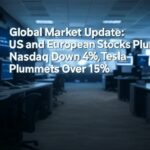Goldman Sachs’ Chief Economist Jan Hatzius and his team have significantly lowered their forecast for US GDP growth in 2025, reducing it from 2.4% to 1.7%. The revision is due to unfavorable assumptions about US trade policy. Additionally, Goldman Sachs has also lowered its year-end target for the S&P 500, dropping it from 6,500 to 6,200 points, citing economic growth concerns and a sharp decline in the stock prices of the “Big Seven” tech companies.
Rising Recession Risks
Discussions around a potential US recession are intensifying. Amid concerns over tariff policies introduced by President Trump, Wall Street analysts have adjusted their economic forecasts. On March 12, Alec Kersman, Managing Director and Head of Asia Pacific at Pimco, warned that the probability of a US recession in 2025 has risen significantly to 35%, more than double the 15% estimate from December last year.
Investor caution is increasing as US stock markets struggle to recover. Following a major sell-off on “Black Monday,” the Dow Jones Industrial Average fell over 1% at one point. By the close, the Dow was down 0.2%, while the Nasdaq and S&P 500 showed modest gains of 1.2% and 0.49%, respectively.
Impact of Tariffs and Economic Outlook
Under mounting trade tensions, Goldman Sachs has issued a stark warning. This marks the first time in over two years that the firm has revised its US economic expectations downward. Hatzius and his team attribute the downgrade to concerns over trade policies that could negatively impact the broader economy.
In addition to lowering the GDP forecast, Goldman Sachs analysts, including David J. Kostin, Ben Snider, and Ryan Hammond, have revised their earnings-per-share (EPS) growth projections. The 2025 EPS growth forecast has been cut from 9% to 7%, with new estimates at $262 (previously $268) for 2025 and $280 (previously $288) for 2026.
Goldman Sachs also expects US tariffs to increase significantly, with the average tariff rate projected to rise by 10 percentage points this year—double the previous forecast and five times higher than during Trump’s first term. Hatzius outlined three main economic risks associated with tariffs:
- Inflationary Pressure – New tariffs will push up inflation, reducing consumers’ real income.
- Tighter Financial Conditions – Increased tariffs will lead to higher market funding costs.
- Investment Uncertainty – Businesses may delay investment decisions due to the unpredictable trade environment.
Due to these factors, Goldman Sachs has raised its forecast for the Personal Consumption Expenditures (PCE) Price Index, expecting core PCE to hit 3% by year-end—higher than the previous estimate of 2%. Since core PCE is the Federal Reserve’s preferred inflation gauge, this could delay potential interest rate cuts.
Federal Reserve’s Policy Response
Given the risks of slowing economic growth and persistent inflation, Goldman Sachs predicts the Federal Reserve may cut interest rates twice this year, likely in June and December. However, policy uncertainty could keep the Fed on hold in the short term.
The shift in Goldman Sachs’ outlook reflects growing concerns over “stagflation”—a combination of stagnant economic growth and high inflation. Market expectations of a US recession before the end of 2025 have surged, with Polymarket data showing a 40% probability as of March 10, up from 23% on February 27.
Market and Political Reactions
Despite rising recession fears, former President Trump dismissed the concerns, stating he does not foresee a downturn and believes the US economy will prosper. He emphasized the need to address the country’s $36 trillion debt.
Wall Street remains cautious. JPMorgan’s Andrew Taylor, Head of Global Market Intelligence, warned that given economic uncertainties, investors should be wary of short-term stock market rebounds. Nomura Securities strategist Charlie McElligott noted that the US is experiencing a “phase shift” in economic policy, which could lead to significant short-term pain.
Some analysts believe that the Trump administration’s policies may be designed to create an “engineered recession,” resetting the economy to reduce reliance on government stimulus and rebalance global trade. Financial blog ZeroHedge suggests that while Trump may not actively seek a recession, the administration could use economic downturns to blame previous debt accumulation on the Biden administration.
In this uncertain environment, experts predict that if a recession does occur, Congress may respond with large-scale fiscal stimulus. While this could stabilize markets ahead of the 2026 midterm elections, short-term economic challenges may persist.



